Plan of Action for Police: Peel's Principles and Community Policing
VerifiedAdded on 2022/11/13
|7
|1109
|417
Report
AI Summary
This report presents a detailed action plan for police departments, grounded in Sir Robert Peel's nine principles of policing, with the aim of fostering community-friendly policing. The plan targets improving relationships with diverse cultural populations, including African Americans, Hispanics, Asians, Native Americans, LGBTQ individuals, and Muslims. It outlines specific initiatives focused on crime prevention, obtaining public approval, voluntary observance of the law, public cooperation, impartial enforcement, minimal use of force, maintaining police-public relationships, limiting police power, and testing police effectiveness through the absence of crime. Each initiative includes objectives, activities, and anticipated outcomes, emphasizing the importance of building trust, respect, and cooperation between law enforcement and the public. The plan references key sources, including works by Adegbile, Williams, Cordner, Emsley, and Loader, to support its strategies and recommendations.
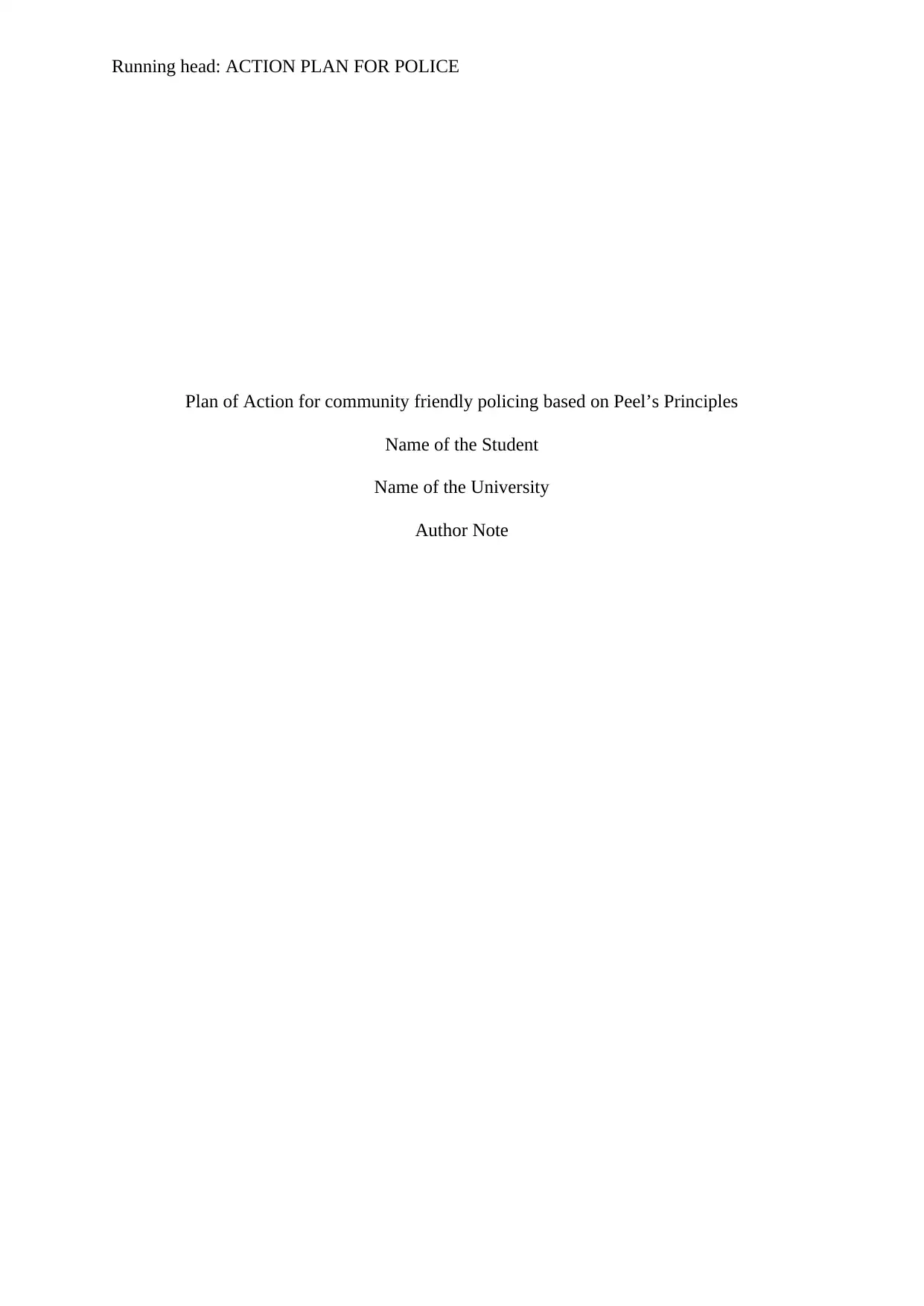
Running head: ACTION PLAN FOR POLICE
Plan of Action for community friendly policing based on Peel’s Principles
Name of the Student
Name of the University
Author Note
Plan of Action for community friendly policing based on Peel’s Principles
Name of the Student
Name of the University
Author Note
Paraphrase This Document
Need a fresh take? Get an instant paraphrase of this document with our AI Paraphraser
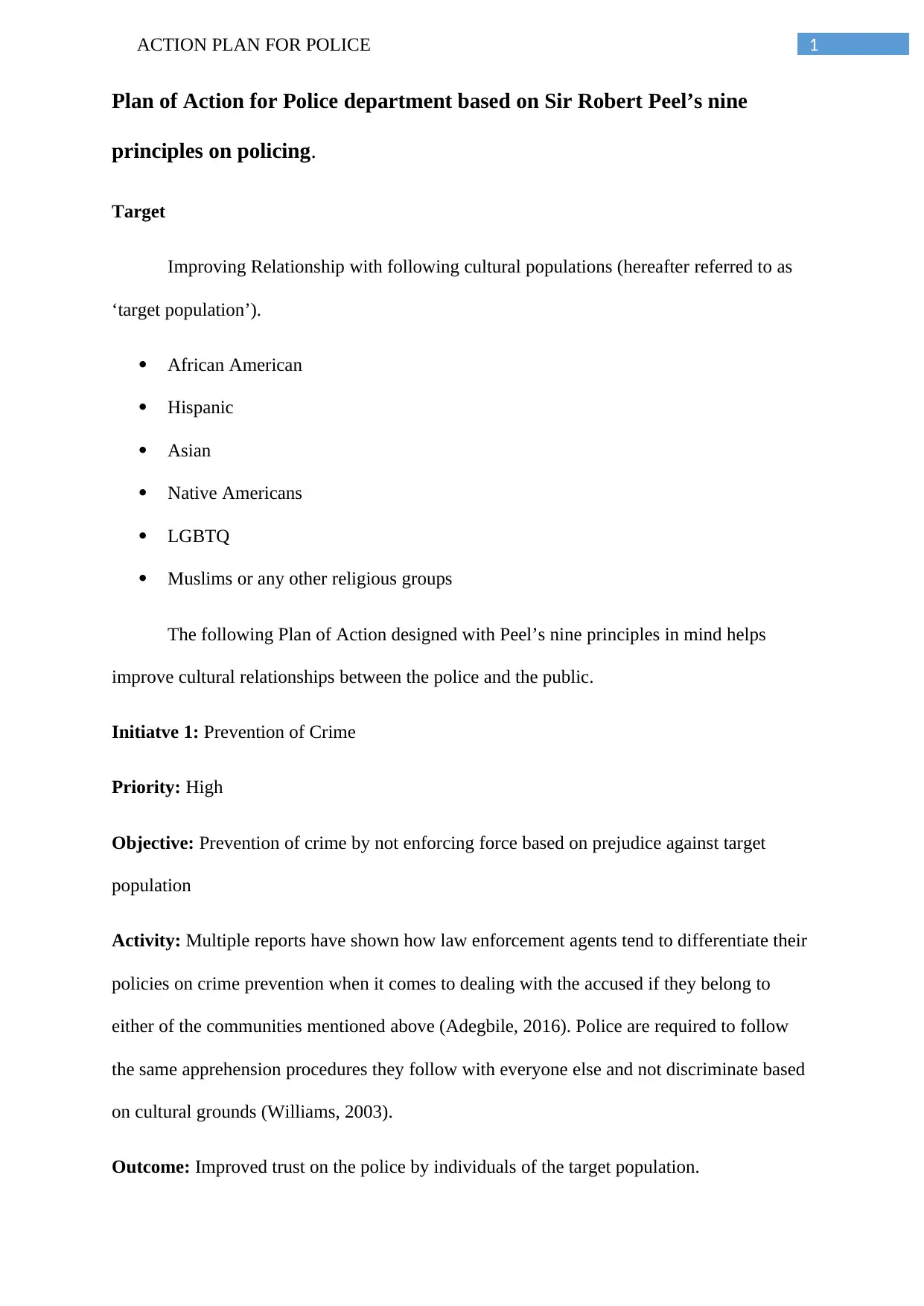
1ACTION PLAN FOR POLICE
Plan of Action for Police department based on Sir Robert Peel’s nine
principles on policing.
Target
Improving Relationship with following cultural populations (hereafter referred to as
‘target population’).
African American
Hispanic
Asian
Native Americans
LGBTQ
Muslims or any other religious groups
The following Plan of Action designed with Peel’s nine principles in mind helps
improve cultural relationships between the police and the public.
Initiatve 1: Prevention of Crime
Priority: High
Objective: Prevention of crime by not enforcing force based on prejudice against target
population
Activity: Multiple reports have shown how law enforcement agents tend to differentiate their
policies on crime prevention when it comes to dealing with the accused if they belong to
either of the communities mentioned above (Adegbile, 2016). Police are required to follow
the same apprehension procedures they follow with everyone else and not discriminate based
on cultural grounds (Williams, 2003).
Outcome: Improved trust on the police by individuals of the target population.
Plan of Action for Police department based on Sir Robert Peel’s nine
principles on policing.
Target
Improving Relationship with following cultural populations (hereafter referred to as
‘target population’).
African American
Hispanic
Asian
Native Americans
LGBTQ
Muslims or any other religious groups
The following Plan of Action designed with Peel’s nine principles in mind helps
improve cultural relationships between the police and the public.
Initiatve 1: Prevention of Crime
Priority: High
Objective: Prevention of crime by not enforcing force based on prejudice against target
population
Activity: Multiple reports have shown how law enforcement agents tend to differentiate their
policies on crime prevention when it comes to dealing with the accused if they belong to
either of the communities mentioned above (Adegbile, 2016). Police are required to follow
the same apprehension procedures they follow with everyone else and not discriminate based
on cultural grounds (Williams, 2003).
Outcome: Improved trust on the police by individuals of the target population.
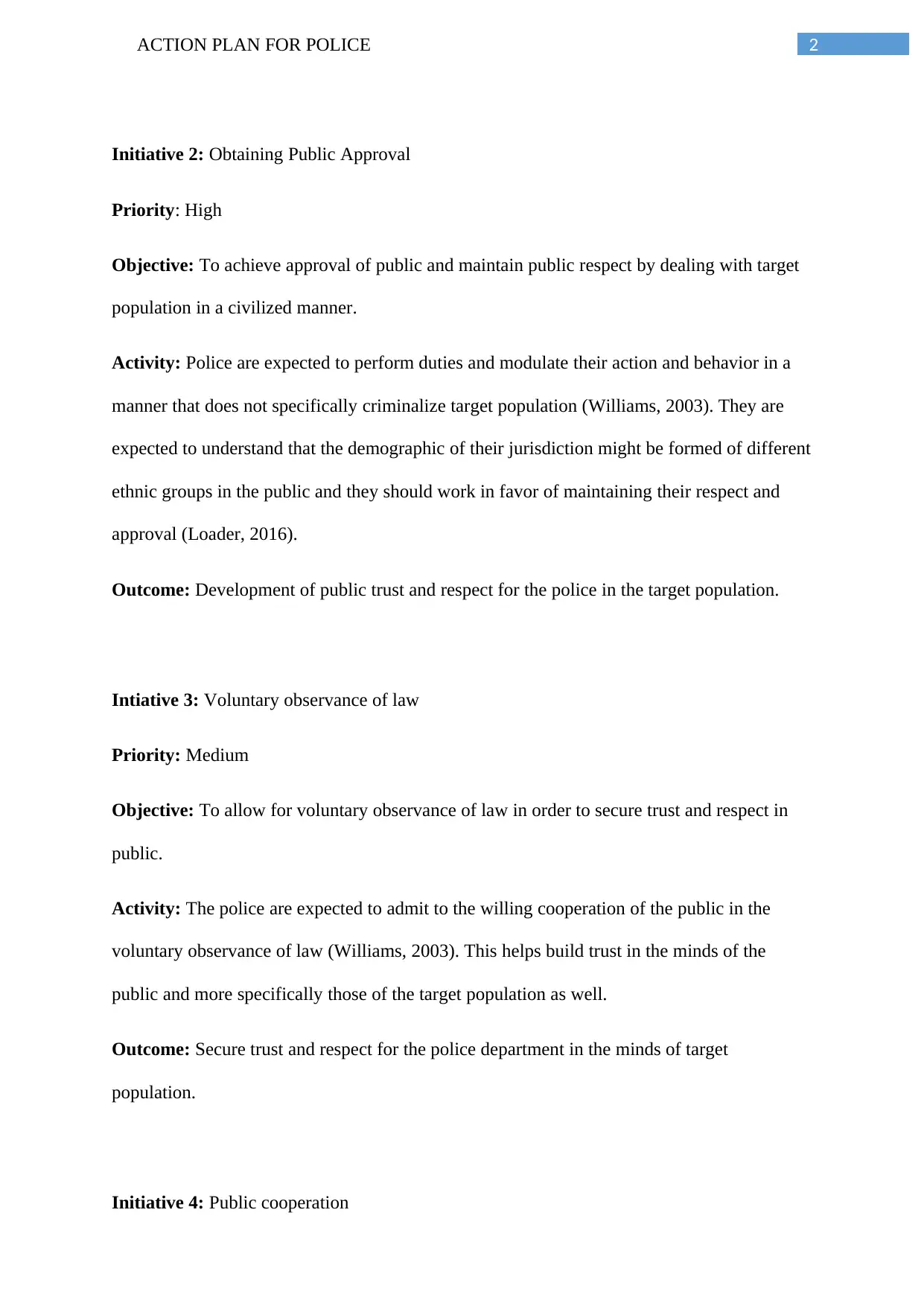
2ACTION PLAN FOR POLICE
Initiative 2: Obtaining Public Approval
Priority: High
Objective: To achieve approval of public and maintain public respect by dealing with target
population in a civilized manner.
Activity: Police are expected to perform duties and modulate their action and behavior in a
manner that does not specifically criminalize target population (Williams, 2003). They are
expected to understand that the demographic of their jurisdiction might be formed of different
ethnic groups in the public and they should work in favor of maintaining their respect and
approval (Loader, 2016).
Outcome: Development of public trust and respect for the police in the target population.
Intiative 3: Voluntary observance of law
Priority: Medium
Objective: To allow for voluntary observance of law in order to secure trust and respect in
public.
Activity: The police are expected to admit to the willing cooperation of the public in the
voluntary observance of law (Williams, 2003). This helps build trust in the minds of the
public and more specifically those of the target population as well.
Outcome: Secure trust and respect for the police department in the minds of target
population.
Initiative 4: Public cooperation
Initiative 2: Obtaining Public Approval
Priority: High
Objective: To achieve approval of public and maintain public respect by dealing with target
population in a civilized manner.
Activity: Police are expected to perform duties and modulate their action and behavior in a
manner that does not specifically criminalize target population (Williams, 2003). They are
expected to understand that the demographic of their jurisdiction might be formed of different
ethnic groups in the public and they should work in favor of maintaining their respect and
approval (Loader, 2016).
Outcome: Development of public trust and respect for the police in the target population.
Intiative 3: Voluntary observance of law
Priority: Medium
Objective: To allow for voluntary observance of law in order to secure trust and respect in
public.
Activity: The police are expected to admit to the willing cooperation of the public in the
voluntary observance of law (Williams, 2003). This helps build trust in the minds of the
public and more specifically those of the target population as well.
Outcome: Secure trust and respect for the police department in the minds of target
population.
Initiative 4: Public cooperation
⊘ This is a preview!⊘
Do you want full access?
Subscribe today to unlock all pages.

Trusted by 1+ million students worldwide
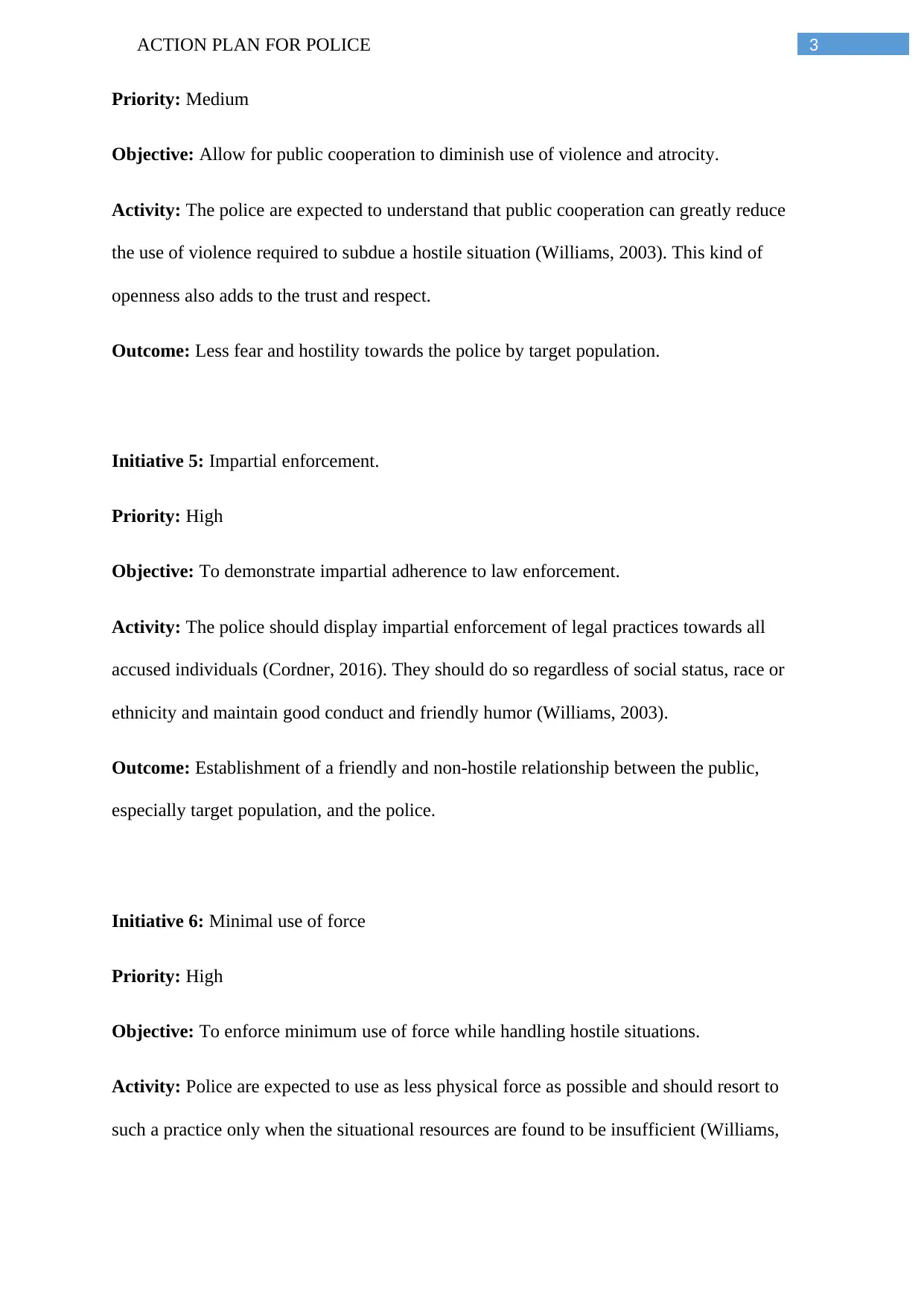
3ACTION PLAN FOR POLICE
Priority: Medium
Objective: Allow for public cooperation to diminish use of violence and atrocity.
Activity: The police are expected to understand that public cooperation can greatly reduce
the use of violence required to subdue a hostile situation (Williams, 2003). This kind of
openness also adds to the trust and respect.
Outcome: Less fear and hostility towards the police by target population.
Initiative 5: Impartial enforcement.
Priority: High
Objective: To demonstrate impartial adherence to law enforcement.
Activity: The police should display impartial enforcement of legal practices towards all
accused individuals (Cordner, 2016). They should do so regardless of social status, race or
ethnicity and maintain good conduct and friendly humor (Williams, 2003).
Outcome: Establishment of a friendly and non-hostile relationship between the public,
especially target population, and the police.
Initiative 6: Minimal use of force
Priority: High
Objective: To enforce minimum use of force while handling hostile situations.
Activity: Police are expected to use as less physical force as possible and should resort to
such a practice only when the situational resources are found to be insufficient (Williams,
Priority: Medium
Objective: Allow for public cooperation to diminish use of violence and atrocity.
Activity: The police are expected to understand that public cooperation can greatly reduce
the use of violence required to subdue a hostile situation (Williams, 2003). This kind of
openness also adds to the trust and respect.
Outcome: Less fear and hostility towards the police by target population.
Initiative 5: Impartial enforcement.
Priority: High
Objective: To demonstrate impartial adherence to law enforcement.
Activity: The police should display impartial enforcement of legal practices towards all
accused individuals (Cordner, 2016). They should do so regardless of social status, race or
ethnicity and maintain good conduct and friendly humor (Williams, 2003).
Outcome: Establishment of a friendly and non-hostile relationship between the public,
especially target population, and the police.
Initiative 6: Minimal use of force
Priority: High
Objective: To enforce minimum use of force while handling hostile situations.
Activity: Police are expected to use as less physical force as possible and should resort to
such a practice only when the situational resources are found to be insufficient (Williams,
Paraphrase This Document
Need a fresh take? Get an instant paraphrase of this document with our AI Paraphraser
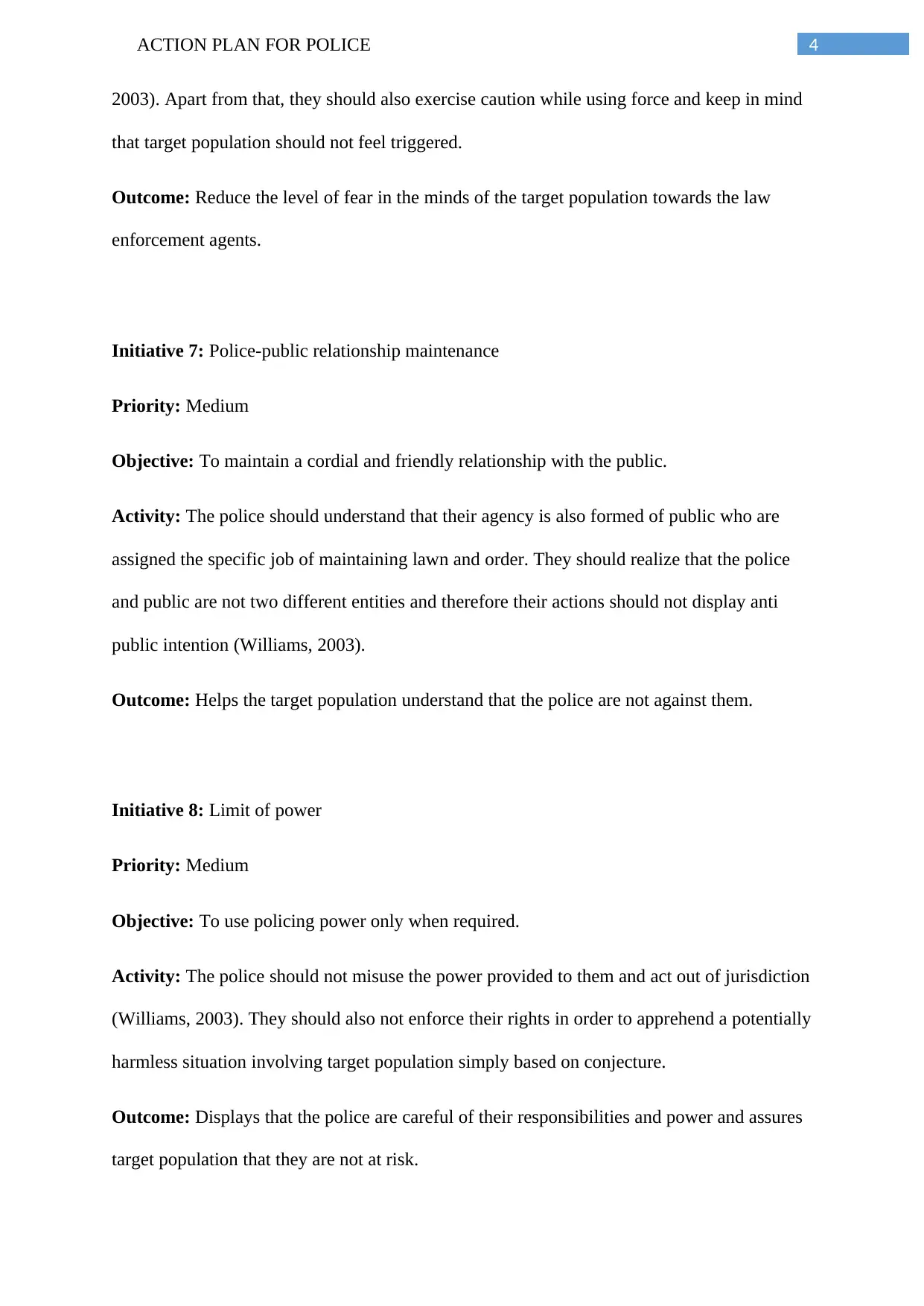
4ACTION PLAN FOR POLICE
2003). Apart from that, they should also exercise caution while using force and keep in mind
that target population should not feel triggered.
Outcome: Reduce the level of fear in the minds of the target population towards the law
enforcement agents.
Initiative 7: Police-public relationship maintenance
Priority: Medium
Objective: To maintain a cordial and friendly relationship with the public.
Activity: The police should understand that their agency is also formed of public who are
assigned the specific job of maintaining lawn and order. They should realize that the police
and public are not two different entities and therefore their actions should not display anti
public intention (Williams, 2003).
Outcome: Helps the target population understand that the police are not against them.
Initiative 8: Limit of power
Priority: Medium
Objective: To use policing power only when required.
Activity: The police should not misuse the power provided to them and act out of jurisdiction
(Williams, 2003). They should also not enforce their rights in order to apprehend a potentially
harmless situation involving target population simply based on conjecture.
Outcome: Displays that the police are careful of their responsibilities and power and assures
target population that they are not at risk.
2003). Apart from that, they should also exercise caution while using force and keep in mind
that target population should not feel triggered.
Outcome: Reduce the level of fear in the minds of the target population towards the law
enforcement agents.
Initiative 7: Police-public relationship maintenance
Priority: Medium
Objective: To maintain a cordial and friendly relationship with the public.
Activity: The police should understand that their agency is also formed of public who are
assigned the specific job of maintaining lawn and order. They should realize that the police
and public are not two different entities and therefore their actions should not display anti
public intention (Williams, 2003).
Outcome: Helps the target population understand that the police are not against them.
Initiative 8: Limit of power
Priority: Medium
Objective: To use policing power only when required.
Activity: The police should not misuse the power provided to them and act out of jurisdiction
(Williams, 2003). They should also not enforce their rights in order to apprehend a potentially
harmless situation involving target population simply based on conjecture.
Outcome: Displays that the police are careful of their responsibilities and power and assures
target population that they are not at risk.
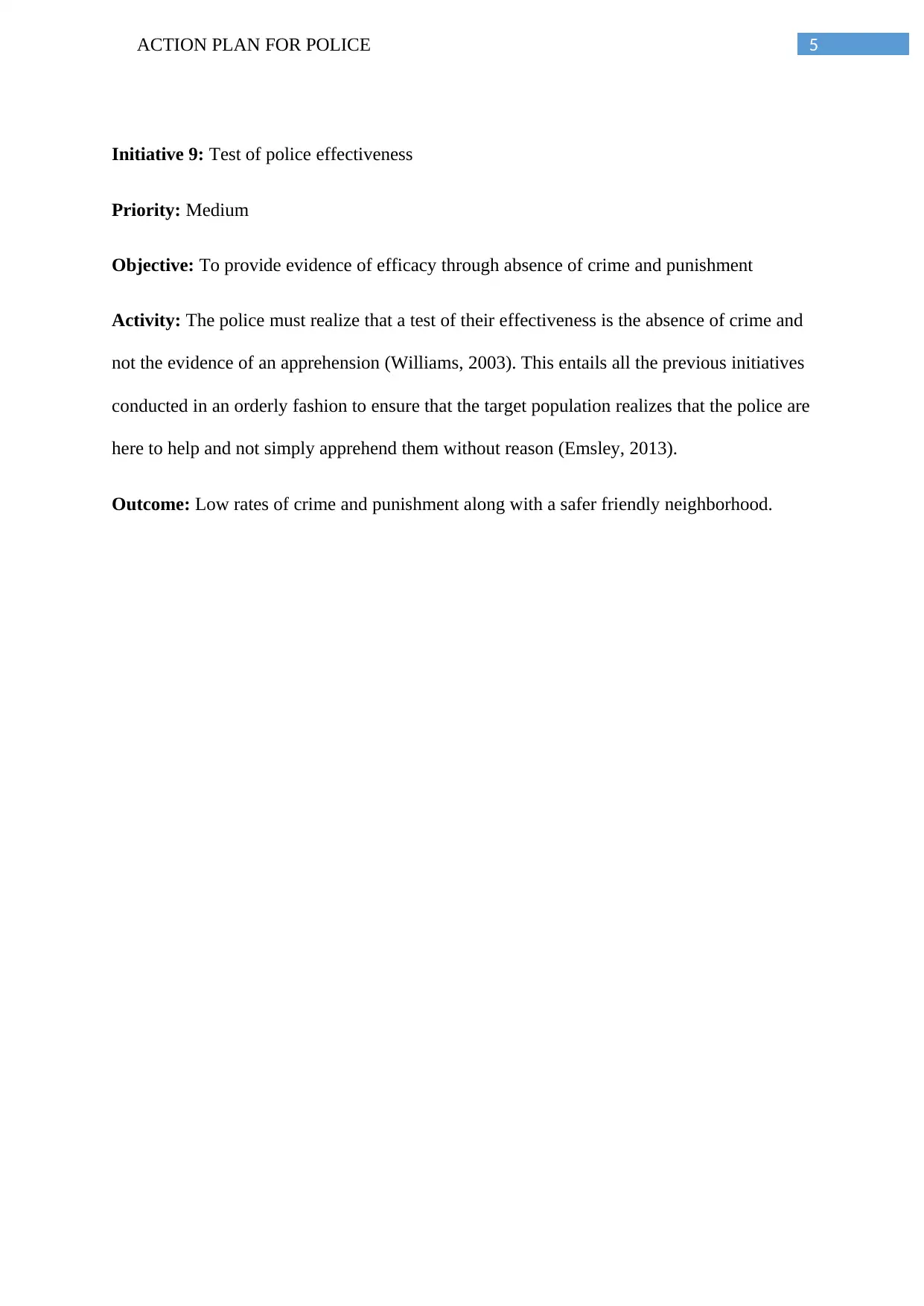
5ACTION PLAN FOR POLICE
Initiative 9: Test of police effectiveness
Priority: Medium
Objective: To provide evidence of efficacy through absence of crime and punishment
Activity: The police must realize that a test of their effectiveness is the absence of crime and
not the evidence of an apprehension (Williams, 2003). This entails all the previous initiatives
conducted in an orderly fashion to ensure that the target population realizes that the police are
here to help and not simply apprehend them without reason (Emsley, 2013).
Outcome: Low rates of crime and punishment along with a safer friendly neighborhood.
Initiative 9: Test of police effectiveness
Priority: Medium
Objective: To provide evidence of efficacy through absence of crime and punishment
Activity: The police must realize that a test of their effectiveness is the absence of crime and
not the evidence of an apprehension (Williams, 2003). This entails all the previous initiatives
conducted in an orderly fashion to ensure that the target population realizes that the police are
here to help and not simply apprehend them without reason (Emsley, 2013).
Outcome: Low rates of crime and punishment along with a safer friendly neighborhood.
⊘ This is a preview!⊘
Do you want full access?
Subscribe today to unlock all pages.

Trusted by 1+ million students worldwide
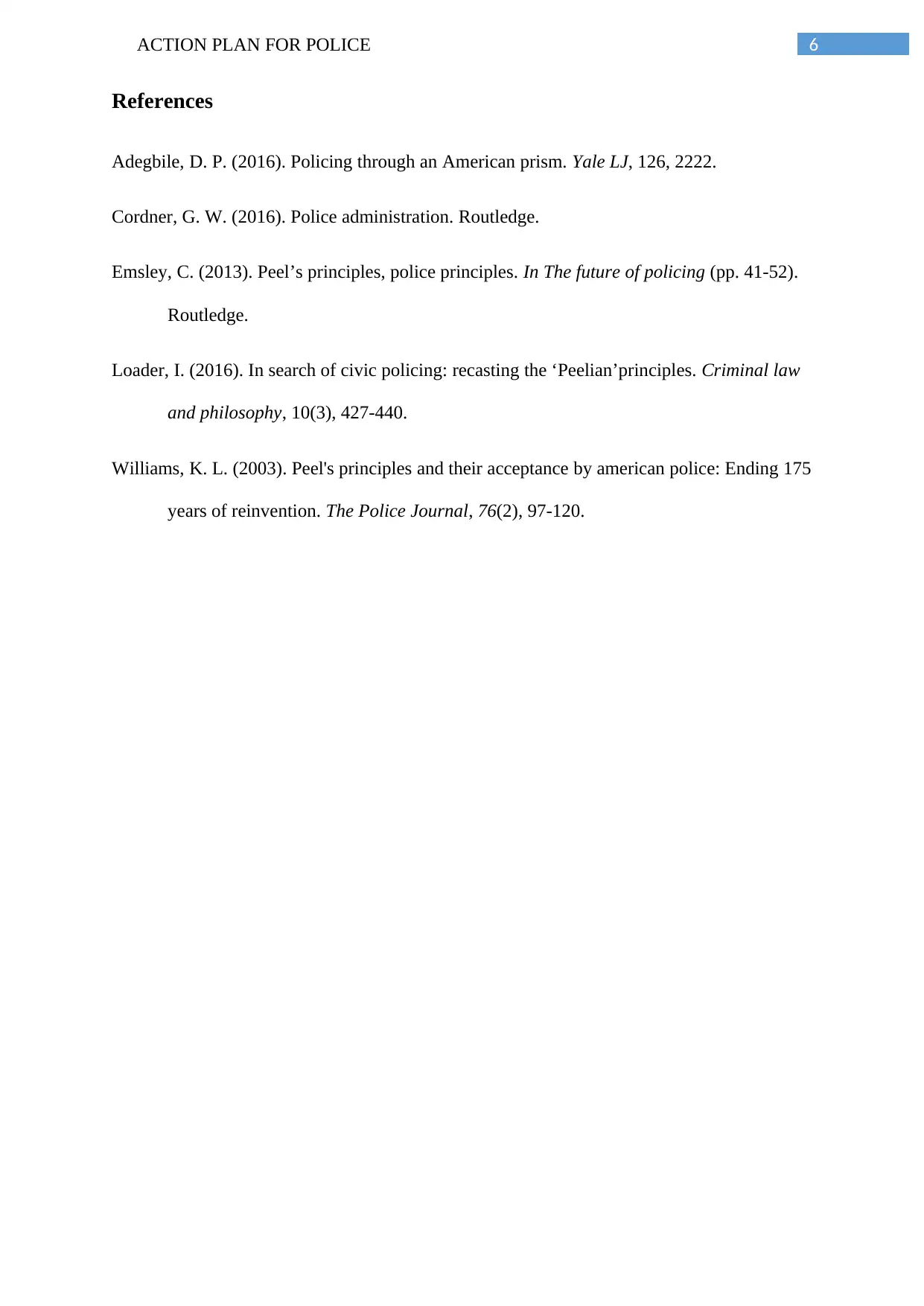
6ACTION PLAN FOR POLICE
References
Adegbile, D. P. (2016). Policing through an American prism. Yale LJ, 126, 2222.
Cordner, G. W. (2016). Police administration. Routledge.
Emsley, C. (2013). Peel’s principles, police principles. In The future of policing (pp. 41-52).
Routledge.
Loader, I. (2016). In search of civic policing: recasting the ‘Peelian’principles. Criminal law
and philosophy, 10(3), 427-440.
Williams, K. L. (2003). Peel's principles and their acceptance by american police: Ending 175
years of reinvention. The Police Journal, 76(2), 97-120.
References
Adegbile, D. P. (2016). Policing through an American prism. Yale LJ, 126, 2222.
Cordner, G. W. (2016). Police administration. Routledge.
Emsley, C. (2013). Peel’s principles, police principles. In The future of policing (pp. 41-52).
Routledge.
Loader, I. (2016). In search of civic policing: recasting the ‘Peelian’principles. Criminal law
and philosophy, 10(3), 427-440.
Williams, K. L. (2003). Peel's principles and their acceptance by american police: Ending 175
years of reinvention. The Police Journal, 76(2), 97-120.
1 out of 7
Your All-in-One AI-Powered Toolkit for Academic Success.
+13062052269
info@desklib.com
Available 24*7 on WhatsApp / Email
![[object Object]](/_next/static/media/star-bottom.7253800d.svg)
Unlock your academic potential
Copyright © 2020–2025 A2Z Services. All Rights Reserved. Developed and managed by ZUCOL.